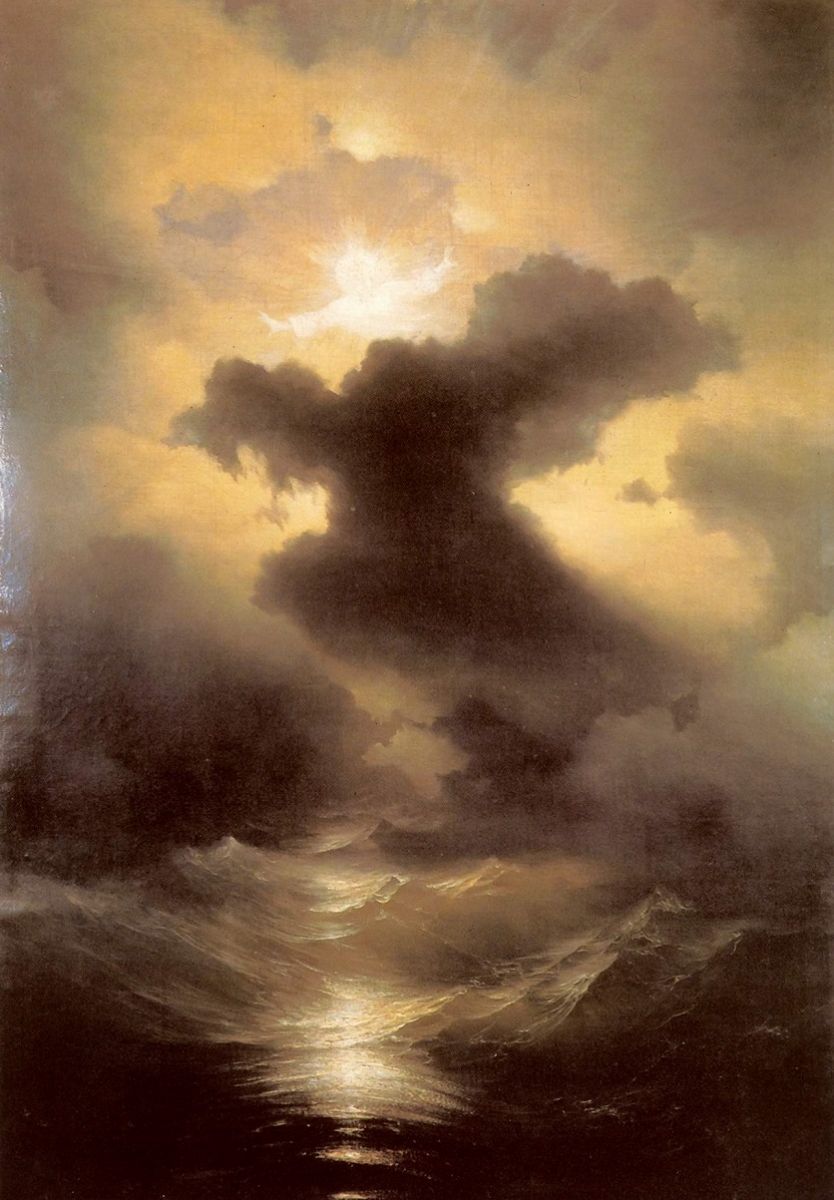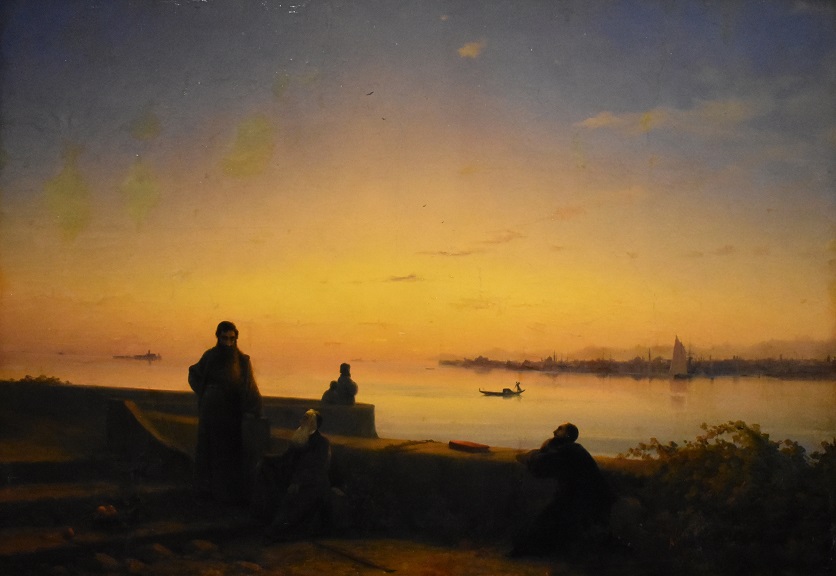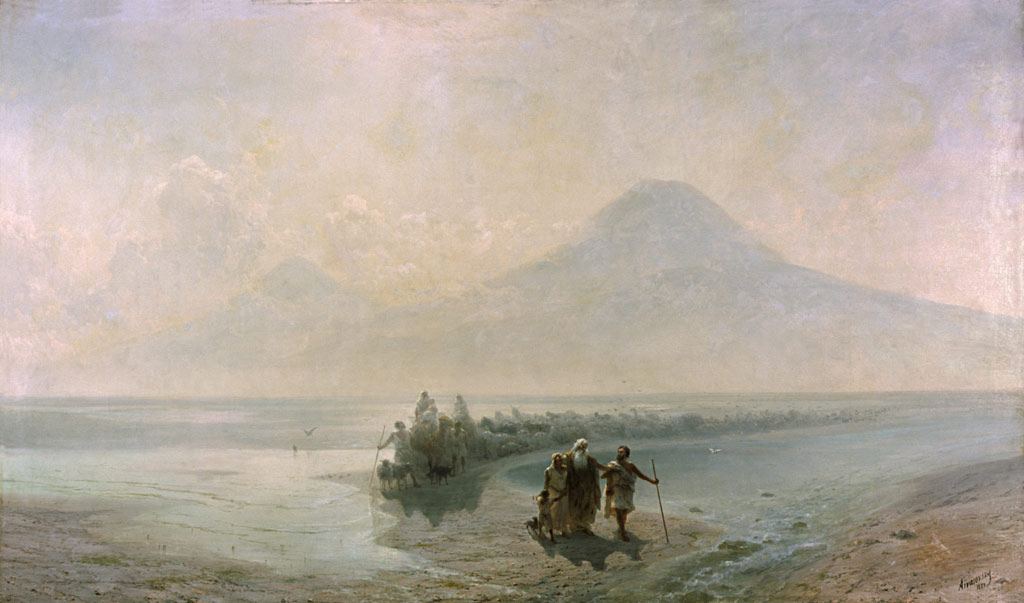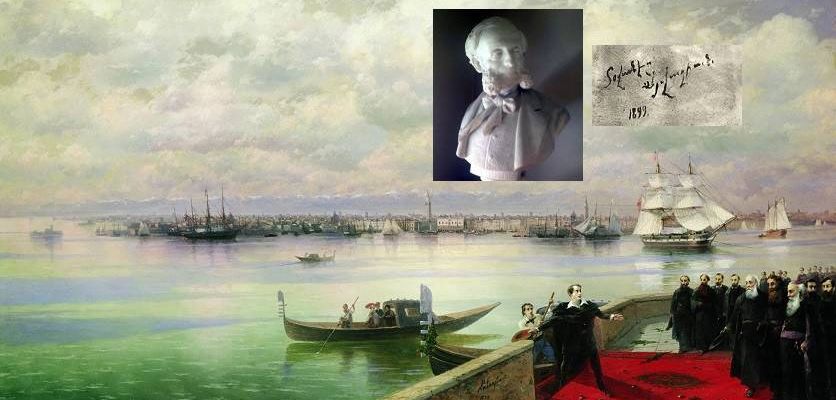How Ivan Aivazovsky, a master of marine art, cherished his Armenian heritage
August 02, 2021
Ivan Aivazovsky, the legendary Russian-Armenian painter of seascapes who lived an eventful life filled with travels, honors, exciting encounters, and long-lasting friendships, enjoyed world-wide recognition during his lifetime and led a prolific creative life, never forgetting his Armenian roots.
Way back in history, the Treaty of San Stefano between Russia and Turkey was signed in a hall decorated with Aivazovsky's paintings. The painter's achievements and appeal resonate to this day: His painting “The Bay of Naples” was sold for a record-breaking 2.3 million pounds at Sotheby's online auction in June 2020; a retrospective exhibition of his works at the Tretyakov Gallery smashed records at the prestigious depository of Russian art in 2016, when more than a hundred thousand tickets were sold ahead of its opening; and in 2017, an exhibition titled “Hovhannes Aivazovsky: Creativity,” celebrating the bicentenary of the painter's birth was held at the National Gallery of Armenia which possesses the second largest collection of his works after the Aivazovsky National Art Gallery in Feodosia, Crimea.
The world is familiar with Ivan Aivazovsky who rose to international fame as a representative of the nineteenth century Russian school of painting. However, “Throughout his life he often returned to Armenian themes through his spirit and imagination,” says Shahen Khachatryan, explaining Aivazovsky's Armenian legacy in The Tretyakov Gallery Magazine.
 “Chaos: The Genesis,” (1841), Museum of Mekhitarist Monastery, Venice (Photo: Wikimedia Commons)
“Chaos: The Genesis,” (1841), Museum of Mekhitarist Monastery, Venice (Photo: Wikimedia Commons)“Light of knowledge”
Khachatryan, a well-respected art connoisseur and former director of the National Gallery of Armenia, describes Aivazovsky’s art as “unique” and “perfect.” He defines this uniqueness as the product of the painter’s faith in human relations, the eternity of life, and the light of knowledge as part of the enlightenment tradition spreading in Europe and resurfacing in Armenian culture thanks to the Mekhitarist fathers. In fact, Aivazovsky was fascinated with the endlessly mysterious universe and painted several variations of his own vision of the “Creation of the world,” one of which he donated to the Mother See of Holy Etchmiadzin. Another version, “Chaos: The Genesis,” is on display at the museum of the Mekhitarist Monastery in Venice.
Aivazovsky’s immense contribution to Russian and Armenian art as a pioneer seascape artist is undeniable. He influenced a whole generation of marine painters and had tremendous impact on Armenian artists in general, including Gevorg Bashinjaghian and Vardges Sureniants, just to name a few.
“It was due to him, and to the charm of his oeuvre, that a constellation of Armenian marine painters emerged, while virtually all the Armenian painters of the second half of the nineteenth century received his blessing,” says Khachatryan.
Aivazovsky painted the sea not the way it was, but the way he saw it in his childhood. He painted hills, mountains, and the sea in colors that would emphasize their subtle beauty. Khachatryan likes to point out the unusual perspectives from which the painter portrays the sea and nature, relying on impression and imagination.
According to Khachatryan, Aivazovsky adopted a poetic approach: “One can always find something ideological in his pieces; they instill ideas in the viewer’s mind,” he says.
Aivazovsky had an exceptional ability to depict a realistic interplay of water and light. The way he conveys transparency and the reflection of light on moving waves is particularly captivating. Khachatryan quotes the great Armenian painter Martiros Sarian as saying that "even in heavy clouds hanging low over stormy seas there is a beam of light, shining feebly, proclaiming salvation." Sarian believed that Aivazovsky depicted his ancestors' faith in this light.

A Russian artist with an Armenian soul
Baptized as Hovhannes Aivazian, the painter was born into an Armenian family of immigrants who had settled at the port of Feodosia—an Armenian priest recorded his birth in 1817. Even though the artist’s father replaced the “ian” ending of his Armenian surname with the Polish “sky,” he had married an Armenian woman, and brought up his five children in the vibrant Armenian community of Feodosia.
Armenians had long been culturally, economically and politically influential in Crimea. Often referred to as “Armenia on the sea,” Feodosia alone had dozens of Armenian churches, and its mountainous landscape resembled that of Armenia. “The painter was inspired by its refined shapes and saturated colors beckoning towards a remote homeland,” says Khachatryan.
Aivazovsky’s unparalleled talent and artistic spirit were evident early on. From a young age he caught the attention of prominent artists and influential people who recognized his unique skills in the arts and helped him rise to fame. It was largely thanks to the mayor of Feodosia that Aivazovsky was admitted to the Russian Imperial Academy of Arts, where he befriended and interacted with a number of eminent figures. He was later sent to master his skills in a Europe steeped in romanticism.
Gabriel Aivazovsky, an archbishop, educator, and historian, was a close confidant of his brother. As a member of the Mekhitarist Armenian congregation on the Island of San Lazzaro, he brought the painter closer to his Armenian roots. Both brothers relied on each other’s support and valued each other’s talents and perspectives. On his first visit to the island in 1840, the painter studied the Armenian illuminated manuscripts at the congregation’s library. In 1843 he painted his “Mekhitarist Monks on San Lazzaro degli Armeni,” which depicts his brother Gabriel and Father Harutyun Avgerian, lexicographer and abbot of the Mekhitarist Monastery in Venice. The centerpiece of the painting, however, is the red book on the stone, an Armenian dictionary published by the monastery.
Whenever the painter visited San Lazzaro, he would always stay in the same room where the British poet Lord Byron used to stay during his earlier visits to the island—the poet had even studied the Armenian language with Father Harutyun Avgerian and collaborated with him to produce an introduction to the “Grammar of English and Armenian Languages.” Byron’s persona, as well as his interest in the Armenian language and culture might have inspired the artist to dedicate a painting to him: The famous masterpiece, “Lord Byron’s Visit to San Lazzaro degli Armeni,” can be admired at the National Gallery of Armenia.
.jpg) “Lord Byron’s Visit to San Lazzaro degli Armeni,” (1899), National Gallery of Armenia (Photo: Wikimedia Commons)
“Lord Byron’s Visit to San Lazzaro degli Armeni,” (1899), National Gallery of Armenia (Photo: Wikimedia Commons)Ready to serve his nation
Even though Aivazovsky lived far from Armenia, many of his letters, paintings, and actions point to the fact that he always felt a strong connection to Armenia and was always willing to serve his people. He has famously claimed that his marriage to Anna Burnazian, his second wife, brought him closer to his nation.
During his travels the painter regularly visited Armenian communities. He wholeheartedly supported Armenian schools and churches by contributing financially or donating his art. Many of his panel paintings adorn the interiors of Armenian churches. He even prevented several Armenian schools from closing down.
Yet Aivazovsky painted Mount Ararat, the River Araks, and Lake Sevan without ever seeing them. After a few failed attempts to visit Armenia, he finally fulfilled his wish and reflected: “I should have visited the unforgettable land of my ancestors much sooner, just to appreciate its beauty.”
As a young boy, Martiros Sarian was present when Aivazovsky donated his now famous painting “The Descent of Noah from Mount Ararat” to an Armenian school in New Nakhichevan. Sarian later found the painting in the ruins of the school and brought it to Armenia. However, because of its religious theme, it was not put on display until the end of the Soviet era.
Even though Aivazosky mainly painted coastal scenes and seascapes, he also painted landscapes, and portraits of prominent Armenians, as well as his own family members. The portrait of his brother Gabriel in religious cloak, and that of Khrimian Hayrik (Armenian Patriarch of Constantinople and later Catholicos of All Armenians) next to a herd of sheep are widely known.
Aivazovsky spoke fluent Armenian and often used Armenian words in his letters written in Russian. The artist’s signature in Armenian can also be noticed on a number of his paintings.
 “The Descent of Noah from Mount Ararat” (1889), National Gallery of Armenia (Photo: Wikimedia Commons)
“The Descent of Noah from Mount Ararat” (1889), National Gallery of Armenia (Photo: Wikimedia Commons)A sorrowful farewell
Aivazovsky was a well-respected artist in the Ottoman Empire. He received prestigious commissions—even from the Sultan. Yet by the end of his life, after a series of massacres of the Armenian population in the Ottoman Empire, he publicly threw his medals into the sea, cut all his ties with the Ottoman authorities, and focused his thoughts on Armenia.
The result were four surreal paintings, the last of which, “Exploding Ship,” was completed on the day he died. The other paintings depict Armenians being killed and thrown into the sea, turning the water red with blood, or stormy seas, which may also allude to the massacres, as Khachatryan observes.
In his lifetime Aivazovsky took part in collective and personal exhibitions all over the world. He became an honorary member of various art academies in Europe and received numerous awards, medals, and orders. He is buried at St. Sargis Church in Feodosia, leaving behind a rich legacy of more than six thousand works.
Join our community and receive regular updates!
Join now!




Attention!